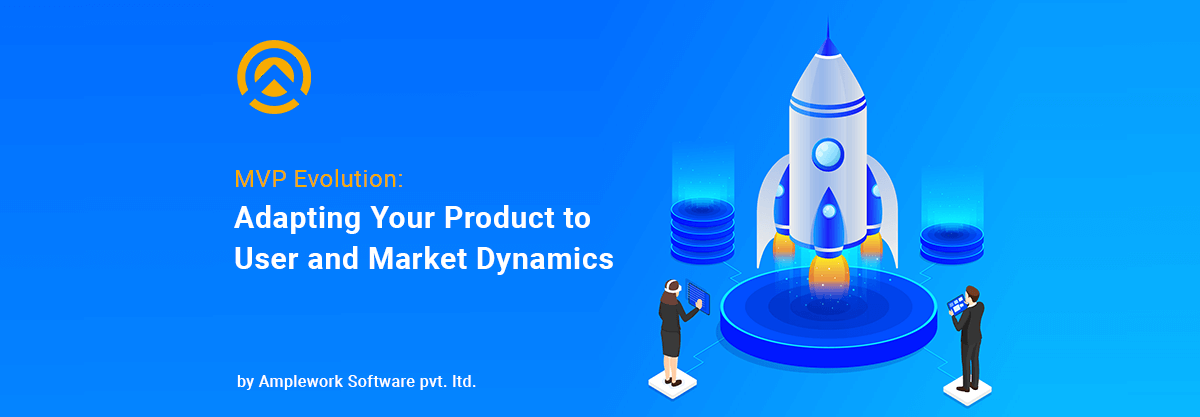You need proper resources for an effective implementation of a business idea and this practice can lead to the best outcomes. The involvement of a Minimum Viable Product (MVP) can effectively bring life to your product. But what you always portray can never be executed effectively without the presence of any challenges or uncertainties. The concept of software development is an intricate maze that is filled with a variety of twists and turns. And can either lead you towards the successful outcomes or the failure.
MVP app development services is the technique from which this uncertainty can be resolved completely. In other words, this technique is defined as the implementation of the product with an accurate or minimum amount of features. Which can become responsible for attracting early adopters customers for validating the product services even being in an early stage. In this context, the research data by MLSDev highlights the developing journey of the MVP technique.
 Source: MLSDev
Source: MLSDev
The above figure highlights the development phase of the MVP practices having the timeframe of 1995 to the current times. The current times these technologies have developed a lot and many platforms have gained impressive success. These well-known platforms are Amazon, Google, WhatsApp, Instagram, Netflix and Uber. This shows all these platforms were developed with the integration of this MVP technique and generated way too positive results even beyond expectations. Along with the ease of service, this technology offers many benefits which subject to improvement according to user feedback and market demand.
Blog Highlights
This blog is all about providing effective information regarding MVP software development and its practices. This practice opens ways for new business holders to establish their businesses according to the availability of the resources. With a quick read of this blog, one can look forward to adopting an accurate MVP product development consultant.
Read more: How to Develop an MVP for Secure Fundraising in 2023
Techniques of MVP Software Development
Technical innovation brings advancements within the existing procedures. The emergence of MVP development results in forming any business in a responsible manner. For the implementation of this, any MVP development company requires following some appropriate steps. These steps of practice are mentioned further.
1. Starting With the Market Research
Market research forms the bedrock of your MVP’s success. This initial step involves a deep dive into understanding your target audience, industry trends, and competitors. You must identify not only who your potential users are but also their pain points and preferences. A thorough market analysis enables you to uncover gaps in the market that your MVP can address. It’s not just about creating a product; it’s about crafting a solution that meets real-world needs. This stage also helps in shaping your MVP’s positioning and messaging for a successful launch.
2. Conducting Value Evolution of the Product
The value evolution technique is about refining your product’s core value proposition. It starts with identifying the essential features that provide the most value to your users. By focusing on these features, one can effectively handle the process of from MVP to product evolution to create a streamlined and impactful MVP. However, it is crucial to recognize that the concept of value evolves over time. As you gather user feedback and analyze the market, you might need to adjust your product’s value proposition to stay aligned with changing user needs and competitive forces.
3. Analyzing the User Flow
The User flow analysis involves a meticulous examination of how users navigate through your MVP. It’s like mapping out a user’s journey within your product, from initial interaction to achieving specific goals. By visualizing this flow, you can pinpoint areas where users might encounter obstacles or confusion. Understanding the user journey allows you to make informed decisions about improving the overall user experience, ensuring that users can easily and intuitively access your MVP’s features.
4. Implementing MVP features on Priority
Prioritizing MVP features is a dynamic process. It starts with identifying the most vital functionalities that directly contribute to your product’s core value. These features must align with your market research findings and user requirements. As you progress, you’ll likely receive valuable feedback from early users. Use this feedback to continuously adjust your feature priorities. This agile approach enables you to adapt to user demands and market trends while keeping your product lean and user-centric.
5. Launching the MVP
The MVP launch is a pivotal moment, but it’s not a standalone event. It’s the start of an ongoing dialogue with your users. When you launch your MVP, consider a phased approach. Begin with a closed beta or soft launch to a limited user base. This strategy allows you to collect vital feedback, analyze user behavior, and validate your product concept. It’s an opportunity to observe how users interact with your solution and make data-driven decisions for future iterations.
6. Practicing Build Measure and Learn
The “Build, Measure, and Learn” cycle is the heart of custom MVP software development and practice. After releasing your MVP, the learning process begins. Collect data and feedback from users, analyze user behavior, and measure key performance indicators. This information helps you evaluate the product’s performance. The insights gained during this phase are invaluable. They guide the development of subsequent MVP iterations, ensuring that each version of your product is an improvement over the last. This iterative process is what enables your product to adapt and evolve continuously to meet changing user needs and market dynamics.
Read more: Prototype vs MVP vs PoC (Proof of Concept): What to Choose?
Major Advantages of MVP Integration

Every business starts with taking care of different factors which are proper market settlement, customer acceptance, proper product valuation, and growth at the same time. The integration of the MVP development technique works on adding different features to the product such as realistic design, reliability, usability, and effective functionality. The MVP development services offer various advantages which are mentioned further.
User-Centric Approach
MVP is rooted in the idea of building a product that directly addresses user needs. It shifts the focus from speculative features to those that users truly desire. Early releases of the product allow you to gather invaluable feedback, helping you understand what works and what needs improvement. By involving users from the beginning, you can create a product that not only meets their expectations but also fosters user loyalty and engagement.
Occurrence of Learning Opportunities
MVP integration is more than just a development strategy; it’s a learning opportunity for your team and organization as a whole. It encourages a culture of innovation, experimentation, and continuous improvement. By releasing and iterating on MVPs, your team gains valuable experience and insight into what works and what doesn’t. This fosters a dynamic and adaptive organizational mindset, ensuring that your company is always ready to embrace change and innovation. It’s not just about building better products; it’s about building better.
Cost Effective Approach
Traditional product development can be expensive, with resources poured into features that may or may not be well-received. MVP reduces upfront costs by concentrating on the essentials. This cost-efficiency is particularly valuable for startups and small businesses with limited budgets. It enables them to invest wisely, allocate resources efficiently, and ensure that every dollar spent contributes to the product’s success.
Faster Development to Approach Market
MVP does not waste time on extensive feature development. By focusing on the core functionalities that users need the most, you can significantly reduce the time it takes to launch your product. This accelerated time to market is especially advantageous in industries where being the first to market can make a substantial difference. It allows you to gain an early foothold, attract early adopters, and start generating revenue sooner.
Iterative Progress of Business
MVP is not a one-and-done effort. It’s an ongoing process of improvement and evolution. After the initial release, you can continue to release new versions of your product, each one building on the last. This iterative approach means that your product is never stagnant; it’s always adapting to the changing needs and preferences of your users. This ensures that your product remains relevant and competitive in the long term.
Resource Optimization
As your MVP gains traction and attracts a user base, you can scale and expand your product features based on the actual needs and preferences of your users. This scalability ensures that your product can grow with your user base, providing the features they desire. It’s a flexible approach that aligns with the evolving requirements of your audience.
Market Responsive
The business landscape is dynamic, and market conditions can change rapidly. MVP’s iterative approach enables you to stay nimble and respond to market shifts and emerging trends. It’s a strategy that allows you to pivot or adjust your product quickly, ensuring that it remains in sync with the market’s demands. Being responsive to market changes is a key factor in maintaining your product’s relevance and competitiveness.
Reduced Risk and Validation
One of the most significant advantages of MVP integration is its risk mitigation capabilities. Instead of developing a full-featured product and hoping it will succeed, MVP allows you to test your concept in the real market. By collecting data and user feedback, you can validate the demand for your product. This early validation minimizes the risk of investing heavily in a product that may not resonate with your target audience.
Scalability and Customization
The practice of MVP gains traction and attracts a user base, you can scale and expand your product features based on the actual needs and preferences of your users. This scalability ensures that your product can grow with your user base, providing the features they desire. It’s a flexible approach that aligns with the evolving requirements of your audience.
Competitive Advantage
By being an early entrant in the market with an MVP, you have the opportunity to capture market share and establish your brand. This early advantage can position your product as a market leader before competitors catch up. Your product can become the go-to choice for users, giving you a competitive edge that can be difficult for others to surpass.
Conclusive Outlines
MVP Advancement plays a pivotal role in making data-driven decisions to ensure product success based on user feedback and market demand. This approach offers tailored insights for various product scenarios. With the increasing need for evidence-based development and optimization, the tech industry has seen visionary developers and forward-thinking organizations working to enhance their products through empirical analysis. Despite initial challenges, many have become pioneers in MVP advancement strategies. In today’s ever-evolving landscape of digital products, the adoption of smart data-driven strategies is more accessible, allowing companies to adapt to modern market demands.
Amplework, a leader in mobile app development with over 5+ years of experience, excels in this field. Our dedicated team consistently surpasses client expectations, earning a reputation for reliability. We’ve achieved significant milestones, contributing to more than $200 million in revenue for various organizations. Explore our website to discover our exceptional services for MVP advancement. Partner with Amplework to embark on a transformative journey toward making data-driven decisions that lead to product success and ultimately improve your product’s quality and user satisfaction.










